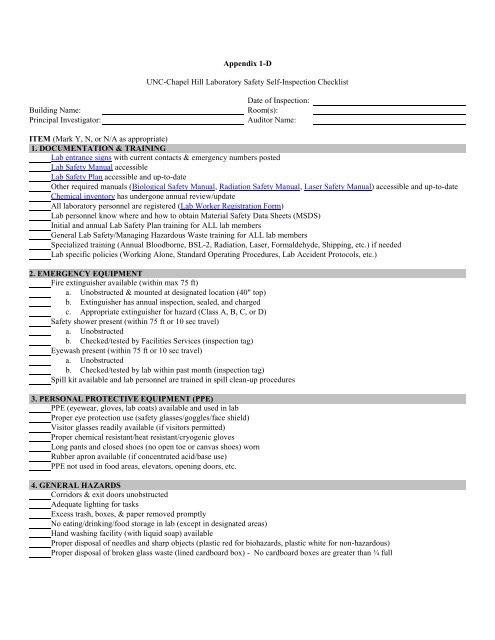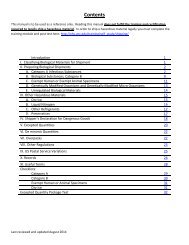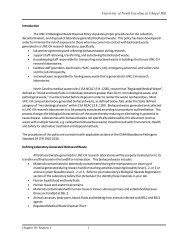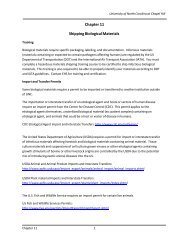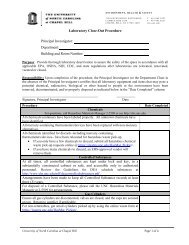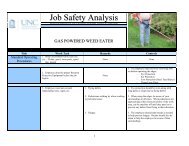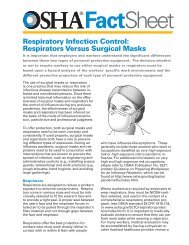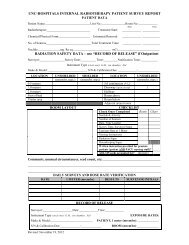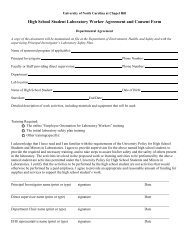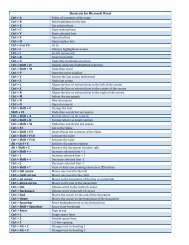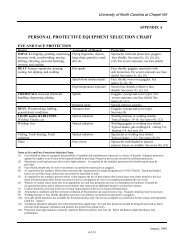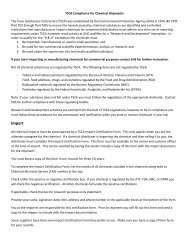Self-Inspection Checklist
Self-Inspection Checklist
Self-Inspection Checklist
Create successful ePaper yourself
Turn your PDF publications into a flip-book with our unique Google optimized e-Paper software.
Appendix 1-D<br />
UNC-Chapel Hill Laboratory Safety <strong>Self</strong>-<strong>Inspection</strong> <strong>Checklist</strong><br />
Building Name:<br />
Principal Investigator:<br />
Date of <strong>Inspection</strong>:<br />
Room(s):<br />
Auditor Name:<br />
ITEM (Mark Y, N, or N/A as appropriate)<br />
1. DOCUMENTATION & TRAINING<br />
Lab entrance signs with current contacts & emergency numbers posted<br />
Lab Safety Manual accessible<br />
Lab Safety Plan accessible and up-to-date<br />
Other required manuals (Biological Safety Manual, Radiation Safety Manual, Laser Safety Manual) accessible and up-to-date<br />
Chemical inventory has undergone annual review/update<br />
All laboratory personnel are registered (Lab Worker Registration Form)<br />
Lab personnel know where and how to obtain Material Safety Data Sheets (MSDS)<br />
Initial and annual Lab Safety Plan training for ALL lab members<br />
General Lab Safety/Managing Hazardous Waste training for ALL lab members<br />
Specialized training (Annual Bloodborne, BSL-2, Radiation, Laser, Formaldehyde, Shipping, etc.) if needed<br />
Lab specific policies (Working Alone, Standard Operating Procedures, Lab Accident Protocols, etc.)<br />
2. EMERGENCY EQUIPMENT<br />
Fire extinguisher available (within max 75 ft)<br />
a. Unobstructed & mounted at designated location (40" top)<br />
b. Extinguisher has annual inspection, sealed, and charged<br />
c. Appropriate extinguisher for hazard (Class A, B, C, or D)<br />
Safety shower present (within 75 ft or 10 sec travel)<br />
a. Unobstructed<br />
b. Checked/tested by Facilities Services (inspection tag)<br />
Eyewash present (within 75 ft or 10 sec travel)<br />
a. Unobstructed<br />
b. Checked/tested by lab within past month (inspection tag)<br />
Spill kit available and lab personnel are trained in spill clean-up procedures<br />
3. PERSONAL PROTECTIVE EQUIPMENT (PPE)<br />
PPE (eyewear, gloves, lab coats) available and used in lab<br />
Proper eye protection use (safety glasses/goggles/face shield)<br />
Visitor glasses readily available (if visitors permitted)<br />
Proper chemical resistant/heat resistant/cryogenic gloves<br />
Long pants and closed shoes (no open toe or canvas shoes) worn<br />
Rubber apron available (if concentrated acid/base use)<br />
PPE not used in food areas, elevators, opening doors, etc.<br />
4. GENERAL HAZARDS<br />
Corridors & exit doors unobstructed<br />
Adequate lighting for tasks<br />
Excess trash, boxes, & paper removed promptly<br />
No eating/drinking/food storage in lab (except in designated areas)<br />
Hand washing facility (with liquid soap) available<br />
Proper disposal of needles and sharp objects (plastic red for biohazards, plastic white for non-hazardous)<br />
Proper disposal of broken glass waste (lined cardboard box) - No cardboard boxes are greater than ¾ full
5. ELECTRICAL<br />
Proper power cord use (good housekeeping, no trip hazard)<br />
a. Extension cords- temporary use, single only (no daisy chains)<br />
b. Power strips (w/surge protection)- computer equipment only<br />
c. No cording through walls, floors or ceiling<br />
Electrical cords not frayed & good insulation<br />
3-pronged plugs not altered; grounding pins in place<br />
Ground Fault Circuit Interrupters on outlets in wet locations<br />
Electrical panels should not be obstructed<br />
6. LABORATORY REFRIGERATOR/FREEZER<br />
"No Food or Drink" sign posted on door<br />
Food/drink not stored in unit<br />
Flammables stored in approved safety refrigerator<br />
In shared rooms emergency contact info posted on equipment<br />
7. CHEMICAL STORAGE<br />
Chemicals stored by Compatibility Group (flammables, oxidizers, acids, bases, reactives, and toxins)<br />
Incompatible chemicals physically separated<br />
Chemicals properly labeled (no chemical formulas)<br />
Storage areas labeled with compatibility group<br />
No excess chemicals on bench tops/in hoods/under sinks<br />
Flammable storage:
12. GAS CYLINDERS<br />
Properly secured (individual chain/cable recommended)<br />
Cylinders in storage labeled as empty or full<br />
Caps on cylinders when not in use<br />
Toxic gases used only in fume hoods or ventilated gas cabinets<br />
13. BIOHAZARD WASTE<br />
Red sharps containers<br />
a. Properly labeled with biohazard symbol<br />
b. Needles are not bent, re-capped, or clipped<br />
c. No sharps containers are greater than 2/3 full<br />
Biological Waste treated in the lab<br />
a. Waste kept in orange biohazard bags in red, hard-walled closable container<br />
b. When autoclaved “X” is placed over biohazard symbol and after treatment placed in white containers<br />
c. Autoclave bioindicator log maintained<br />
d. Chemically disinfected waste – request for approval on file<br />
14. BIOSAFETY LEVEL 2 (BSL2)<br />
Easily cleanable surfaces and laboratory furniture (nonporous chairs)<br />
Hand washing sink<br />
Safety eye wash and emergency shower<br />
Inline HEPA filters<br />
Biohazard symbol on lab equipment used for BSL2 work<br />
Entryway signs denoting BSL2 lab space<br />
Sharps and aerosol generation precautions<br />
Routine decontamination<br />
15. RADIOACTIVE MATERIALS<br />
Lab entrance is posted with “Caution: Radioactive Materials”<br />
“Notice to Employees” sign posted in laboratory<br />
Storage and waste areas should be labeled with “Caution Radioactive Materials”<br />
All materials and sources should be secured by lock and key or personnel attendance<br />
Radioactive material work area should be clearly defined<br />
Records of disposition of isotopes are current<br />
Radiation Safety Manual accessible<br />
16. LASERS (Class 3B and 4)<br />
Laser signs are posted on doors<br />
Protective eyewear is available and in good condition<br />
Warning signs or lights are in proper order<br />
Interlocks are working properly<br />
Unattended laser rooms are locked<br />
Keys are not left in an unattended laser control panel<br />
17. DEA CONTROLLED SUBSTANCES<br />
Controlled substances are stored in locked cabinet or safe<br />
Records of purchases, acquisition, dispensations, and disposal are available<br />
Outdated and unused controlled substances are disposed of in accordance with DEA procedures<br />
18. SELECT AGENT TOXINS<br />
Toxins registered on Schedule F in lab safety plan<br />
Inventory in place and up to date<br />
Current inventory is secure


